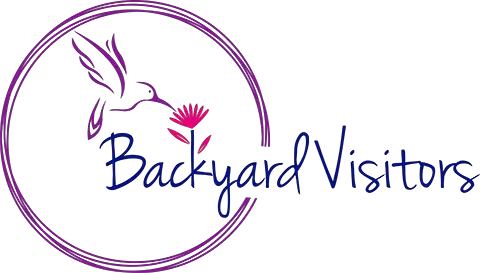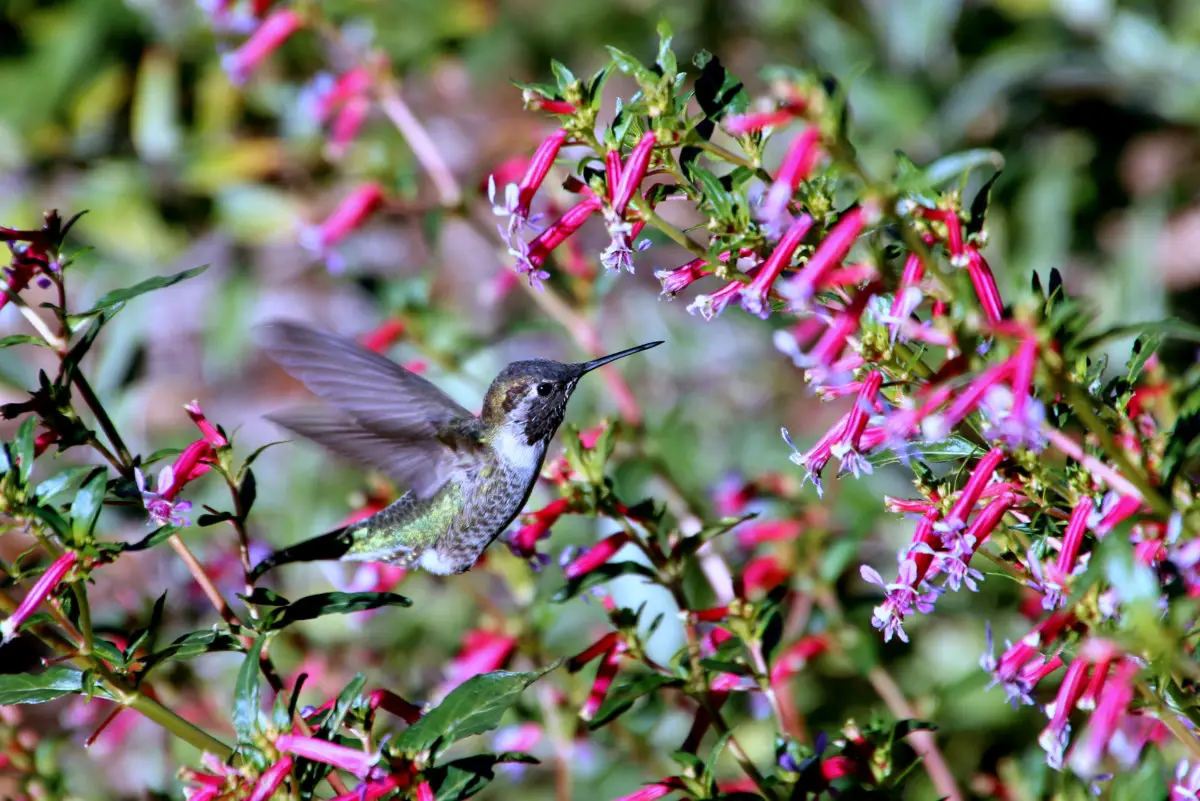This post contains affiliate links.
For such a tiny, speedy and powerful vessel flying through mid-air, a hummingbird must make sure their food intake and quality match their high metabolism. One would be surprised at the types of delectable items on their menu.
What do hummingbirds eat?
Hummingbirds consume nectar and insects to obtain their body’s main nutritional diet needs. The simple sugars in natural nectar from flowering plants or hummingbird feeders provide instant, sufficient and desirable energy. However, dozens to thousands of insects such as gnats, mosquitoes, and spiders are also eaten every day for protein.
Hummingbirds are amazing creatures and are able to adapt to their habitat better than most birds. They actually do not live off of sugar water or nectar alone and need vitamins, fats and proteins to complete a nourishing well-balanced diet.
To be the most powerful aviator in the sky, hummingbirds must acquire their strength and stamina through obtaining desirable quality nourishment along with gaining an enormous quantity of readily available food.
The simple digestible sugars found in nectar provide hummingbirds the quick and necessary fuel to sustain their extremely high metabolism along with a diet of insects. The protein that is consumed from insects sustains and supports their pectoral muscle in their wings to make them remarkably strong and aerodynamic flyers.
Maintaining a hummingbirds high powered endurance level gives them an advantage of protecting their territory, catching bugs in mid-air, displaying a mating dance to show their desired biological traits and hovering for long periods of time as they gather nectar.
What flowers attract hummingbirds in California?
Hummingbirds are attracted to any variety of vividly colored tubular blooming flowers in California. Their menu includes, but not limited to:
- Hot Lips (Salvia microphylla)
- Cigar flower (Cuphea ignea)
- Trumpet Vine (Campsis radicans)
- Honeysuckle (Lonicera)
- Heliotrope (Heliotropium arborescens)
Hummingbirds do not have a strong sense of smell and must trust their vision to locate intensely colored blooming flowers to guide them in seeking their food supply. To do this, hummingbirds must rely heavily on their memory which includes spacial awareness to visually identify familiar objects especially the vivid color red.
Additional color combinations of pink, purple, orange and even shades of yellow are suitable to catch the eye of a foraging hummingbird.
In my experience, I have noticed hummingbirds are attracted to the Salvia plant Hot Lips. These flowers have white on the top and red on the bottom looking like red lips, hence the name “Hot Lips”.
They are a hardy drought tolerant plant and do well in full sun and well-drained soil.
Planting a multitude of colorful variations of this plant will produce spectacular entertainment of territorial activity to watch while consuming a cup of coffee in the morning or enjoying an afternoon lunch.
The Cigar plant is another favorite in the hummingbird diet. The common visual appearance resembles a lit cigar where the idea of the name was derived. They are attracted to the long orange tubular flowers.
Tubular flowers produce the most nectar. These plants prefer sun to partial shade to protect their leaves from burning from the intense midday sun.
The Trumpet Vine or Trumpet Creeper is a vigorous invasive climber with huge flowers that enjoys full sun. The flower color combinations can be red, orange and yellow. Obviously, the red colored Trumpet Vine fare better in attracting hummingbirds.
Climbing vines are used in any outdoor structure and provide a steady thick wall of foliage extending privacy to any outdoor space. They bloom in the summer and fall seasons and are an appealing visual exhibition to attract the hummingbird.
During my childhood, I remember honeysuckles being one of my favorite perennial vines. I recollect tasting droplets of nectar from each bloom as I pretended to be a hummingbird enjoying the fruits of nature.
The honeysuckle is a well-known attractant for hummingbirds. The most popular varieties include:
- Common Honeysuckle (Lonicera periclymenum)
- Japanese Honeysuckle (Lonicera japonica)
- Trumpet or Coral Honeysuckle (Lonicera sempervirens)
- Cape Honeysuckle (Tecomaria capensis)
Despite the Heliotrope plant defying the very quintessential characteristics of what most hummingbirds plants possess, it still stands as a contender. This plant has rich purple flower clusters wafting a vanilla scent. It withstands full sun but enjoys the shade from the harsh afternoon sun.
As the season of abundant flowering plants diminishes other non-synthetic options are providing your hummingbirds with feeders using homemade feeder food. Hummingbird feeders are a great alternative resource for maintaining happy and frequent visitors to your outdoor area throughout the year.
The most successful and least expensive choice of feeding your hummingbirds is to make your own hummingbird feeder food.
How to make homemade hummingbird food for my feeder?
- Dissolve 1 part table sugar to 4 parts distilled water.
- Use a 2 cup Pyrex microwavable glassware and microwave the solution in 30-second increments until the solution is dissolved.
- Make sure the nectar is at room temperature before adding it to your feeder.
- Do not use organic sugar, honey or red dye.
An added benefit to making homemade hummingbird food is knowing that our friends are fed healthy non-synthetic food that is free of artificial coloring or preservatives.
Beware! Many people have the inclination to gravitate towards “organic” labels believing this term means healthy or unadulterated. In the hummingbird world, organic doesn’t always mean better or safer when it comes to nectar solutions.
Use regular cane or table sugar, preferably with distilled water.
In my opinion, it is best to use the homemade hummingbird feeder food immediately and not refrigerate any leftover portions even though some may say it can last in the refrigerator for up to a week.
Bacteria and mold can grow in the homemade hummingbird feeder food being exposed daily to the sun and can cause health problems for hummingbirds.
Even if your feeder is not completely empty, regularly clean and refill your feeder every 5 – 7 days. Beak and tongue infections are common and can be easily avoided with a regularly cleaned feeder.
When the tongue swells or there is a growth spot on the beak these fungal infections cause obstacles making it hard for a hummingbird to consume food causing them to starve.
What kind of bugs do hummingbirds eat?
Besides nectar, hummingbirds are known to eat many different smaller sized insects for protein such as ants, aphids, beetles, caterpillars, gnats, flies, flying ants, fruit flies, insect eggs, leafhoppers, midges, mites, mosquitoes, small beetles, spiders, wasps, weevils and whiteflies.
Consuming bugs within a hummingbirds diet provides essential vitamins, minerals, fats, and amino acids that are not found in nectar.
If you were wondering what a midge resembles just like I was, a midges’ petite body size looks similar to mosquitoes that cluster together in swarms usually seen in the backyard hovering above the grass.
Here is a clip of a hummingbird waiting patiently on a branch and you can actually see the hummingbird’s beak open wide in anticipation of catching an insect.
Hummingbirds and spiders have a symbiotic relationship. A hummingbird’s substantial protein source comes from eating daddy long leg spiders. They especially like to raid the spider web of its silk to make a hummingbird nest and also pluck live spiders or bug carcass out of the center of the web for a snack.
On the other hand, spiders have also been known to catch a hummingbird in their web and can keep it captive like a prisoner to eat for later!
Here is a video of a hummingbird being caught in a web, but luckily had a human watching out for him, saved his life and released him back out into the wild.
Other useful ways of providing easily attainable protein meals are to start a compost that attracts bugs hummingbirds like to eat. Any of your leftover fruits and vegetables that you have accumulated after a meal will be the perfect ingredients to get you started.
I like to have a small container with a sealed lid near the kitchen sink to add all of my table scraps. Once the container is full I will dump the bucket into the compost heap outside.
Layering your compost with wet food items and dry items such as twigs, leaves or grass clippings provide the perfect environment to create worms and fruit flies.
By creating a compost we are simultaneously creating soil for a potential garden, saving the environment and providing easy nutritious snacks for our hummingbird companions.
How much do hummingbirds eat?
Hummingbirds eat about half of their body weight in nectar. They consume the weigh of about 2 instant hot chocolate packets a day. Experts have gathered data on hummingbirds consuming thousands of insects for protein daily. Hummingbirds feed on average every 10 minutes.
Even though hummingbirds are noted for their mechanochemical efficiency (successfully converting food into energy for a hummingbird) they require a plethora of varied nutrients to maintain their daily existence. During daylight hours, hummingbirds are constantly searching for food to replenish their high energy and nutritional needs.
In order to accomplish this goal, hummingbirds have to eat more than they weigh to restore depleted resources. Hummingbirds do not use their tongue like a straw, but instead, are capable of lapping up nectar up to 15 times per second when they feed. They have to eat every 10 minutes and excrete waste every 20 minutes; hence they are in constant search of food.
During the fall and winter migration seasons, hummingbirds are known to consume up to their full body weight daily (approximately 4 oz). The more body fat they can pack before migrating, the better chance they will reach their destination successfully.
Happy hummingbird watching!
Backyard Visitors participates in affiliate programs which compensate us for referring traffic.


